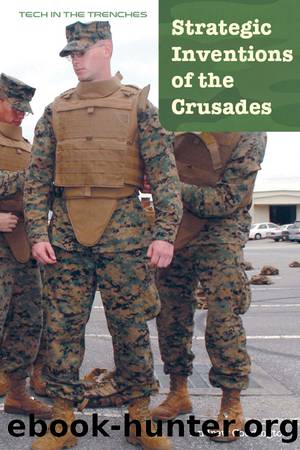Strategic Inventions of the Crusades by Coddington Andrew;

Author:Coddington, Andrew; [Coddington, Andrew]
Language: eng
Format: epub
Publisher: Cavendish Square Publishing LLC
Krak des Chevaliers proved a formidable fortress and survived several attempts to conquer it. In 1188, the mighty Muslim general Saladin besieged the castle and even captured its commander, whom he demanded order his troops within the castle to surrender. According to legend, the commander said just that to the soldiers under his command in Arabic, but afterward spoke in French and ordered them to fight until the last man. The Hospitallers maintained control of the castle until 1271, when it was lost to Muslim forces under Sultan Baybars I, who tricked the defenders into surrendering the castle by delivering a forged letter from their regional commander in Tripoli ordering them to leave.
The Siege of Constantinople
During the Muslim worldâs campaign of conquest in the seventh and eighth centuries, the Arab armies twice tried to capture Constantinople, Christianityâs stronghold in the East and capital of the Byzantine Empire. Constantinople was situated on an elevated peninsula overlooking the Bosporus, the strait connecting the Black Sea with the Sea of Marmara and the Mediterranean, making it of extraordinary strategic value. Capturing the city would open the Eastern door into Europe. However, on both attempts, Constantinople repelled Muslim invaders, in part due to its strong fortifications.
Constantinopleâs fortifications blended superior materials, ingenious architecture, and natural defenses. Its first walls were built by Emperor Constantine (for whom the city was named) in the fourth century CE and completely enclosed the city. In 413, Emperor Theodosius improved Constantineâs design, building a wall that stretched from one side of the peninsula to the other, completely sealing off the city from the mainland. When earthquakes damaged much of the wall in 447, the Byzantines rebuilt it and improved on it, adding an additional shorter, thinner wall known as the outer wall.
Thanks to its fortifications and the leadership of astute commanders, Constantinople was considered one of the bestdefended cities in the known world. However, it seems its greatest threat came from within Christendom, the very religious group protecting it. In 1204, during the Fourth Crusade, Christian soldiers turned mutinous, laying siege to and plundering the city themselves. Constantinople never recovered from the assault, and in 1453 the city fell to the Muslim Ottoman Turks. Remains of Constantinopleâs walls still stand today, in what was renamed Istanbul by the Turks.
Download
This site does not store any files on its server. We only index and link to content provided by other sites. Please contact the content providers to delete copyright contents if any and email us, we'll remove relevant links or contents immediately.
Pale Blue Dot by Carl Sagan(4864)
Cracking the GRE Premium Edition with 6 Practice Tests, 2015 (Graduate School Test Preparation) by Princeton Review(4185)
Pocahontas by Joseph Bruchac(4096)
Unfiltered by Lily Collins(3932)
The Emotionary: A Dictionary of Words That Don't Exist for Feelings That Do by Eden Sher(3286)
The Daily Stoic by Holiday Ryan & Hanselman Stephen(3201)
Factfulness_Ten Reasons We're Wrong About the World_and Why Things Are Better Than You Think by Hans Rosling(3169)
The President Has Been Shot!": The Assassination of John F. Kennedy by Swanson James L(3024)
Rogue Trader by Leeson Nick(2950)
Sapiens and Homo Deus by Yuval Noah Harari(2949)
The 48 laws of power by Robert Greene & Joost Elffers(2896)
The Innovators: How a Group of Hackers, Geniuses, and Geeks Created the Digital Revolution by Walter Isaacson(2708)
The Rape Of Nanking by Iris Chang(2707)
Gettysburg by Iain C. Martin(2628)
Almost Adulting by Arden Rose(2624)
The Plant Paradox by Dr. Steven R. Gundry M.D(2518)
500 Must-Know AP Microeconomics/Macroeconomics Questions(2510)
In the Woods by Tana French(2502)
Make by Mike Westerfield(2259)
